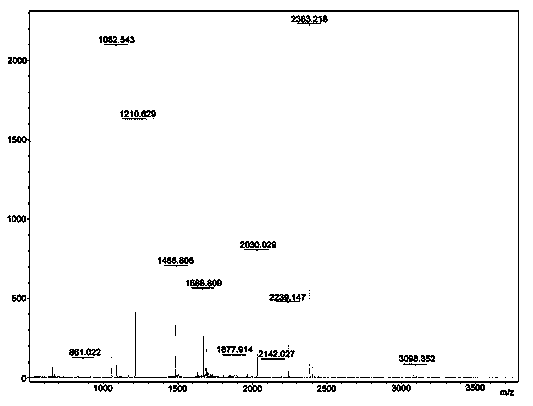Method for finding protein interaction with baculovirus PCNA (Proliferating Cell Nuclear Antigen)
A baculovirus and protein technology, applied in the fields of genetic engineering and biology, can solve the problems of slow onset and lethal effect, high host specificity, and influence on the use of baculovirus.
- Summary
- Abstract
- Description
- Claims
- Application Information
AI Technical Summary
Problems solved by technology
Method used
Image
Examples
Embodiment 1
[0026] Embodiment one: Cloning of PCNA gene of Autographa californica nuclear polyhedrosis virus
[0027] Primers were designed according to the PCNA gene sequence of AcMNPV (GenBank ID: 1403881). PCR primers are:
[0028] Forward: 5'-CGCGGATCCATGTTCGAAGCGGAATTT-3' (the underline is the BamHI restriction site)
[0029] Reverse: 5'-CCGCTCGAGGTGATGGTGATGGTGATG-3' (XhoⅠ restriction site is underlined)
[0030] PCNA fragments were specifically amplified with full gold TransStart FastPfu DNA Polymerase. PCR amplification conditions were pre-denaturation at 94°C for 5 min, denaturation at 94°C for 30 s, annealing at 58°C for 30 s, and extension at 72°C for 40 s, a total of 25 cycles. This was followed by an additional extension at 72°C for 8 min. The PCR product was subjected to agarose electrophoresis, and the 800bp fragment was cut out, and the recovered amplified fragment was purified with the gel extraction kit of Shanghai Jierui. The target fragment was connected to the p...
Embodiment 2
[0032] Embodiment two: expression and purification of PCNA protein
[0033] The PCNA-30a recombinant plasmid was transformed into Escherichia coli BL21 competent cells. Pick the correctly identified target clone and inoculate it in LB medium, culture it in a shaker overnight at 37°C, transfer it to fresh LB medium the next day, and add directly to the bacterial solution when the OD600 of the bacterial solution is 0.6 IPTG for induction. After 8 hours, the induced cells were collected and processed, and the treated cell proteins were subjected to 12% SDS-PAGE electrophoresis, and the proteins after gel separation were transferred to PVDF membranes, and mouse-derived anti-His monoclonal The antibody was immunoreacted, and the Western blot detection result of His-PCNA with 6 X His tag was as follows: figure 1 shown.
[0034] Use 1L Escherichia coli containing PCNA-30a fusion protein expression vector for large-scale induction, centrifuge at 4000g for 15 minutes after induction...
Embodiment 3
[0035] Example 3: Preparation of PCNA coupled CNBr-Activated Sepharose 4B column
[0036]Dissolve 5 mg / mL PCNA in coupling buffer (0.1M NaCO3 containing 0.5M NaCl, pH 8.3). 1mM HCl swells CNBr-Activated Sepharose 4B lyophilized powder. The coupling solution containing PCNA and the swollen CNBr-Activated Sepharose 4B were mixed for 2 hours; pH 8.0, 1M ethanolamine was added to eliminate residual active groups, and the column was packed. Wash the coupling medium alternately 3 times with 0.1 M acetate buffer (pH 4.5) containing 0.5 M NaCl and coupling buffer.
PUM
 Login to View More
Login to View More Abstract
Description
Claims
Application Information
 Login to View More
Login to View More - R&D
- Intellectual Property
- Life Sciences
- Materials
- Tech Scout
- Unparalleled Data Quality
- Higher Quality Content
- 60% Fewer Hallucinations
Browse by: Latest US Patents, China's latest patents, Technical Efficacy Thesaurus, Application Domain, Technology Topic, Popular Technical Reports.
© 2025 PatSnap. All rights reserved.Legal|Privacy policy|Modern Slavery Act Transparency Statement|Sitemap|About US| Contact US: help@patsnap.com



